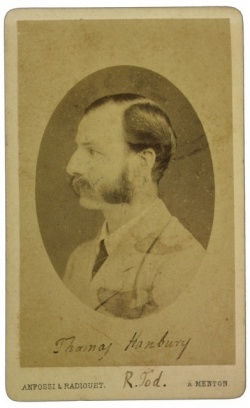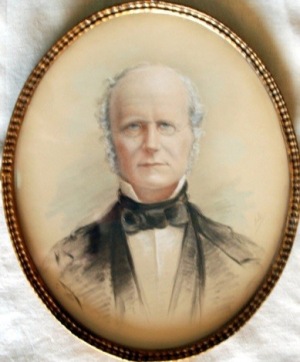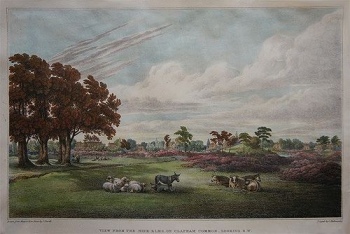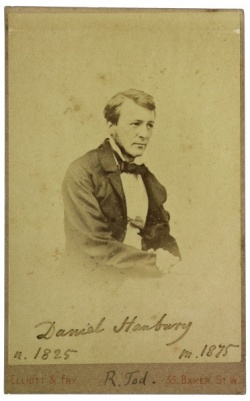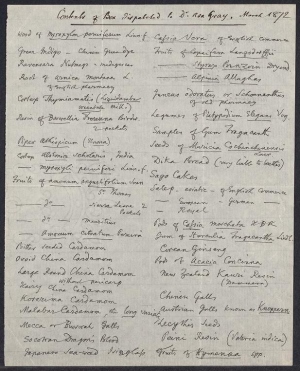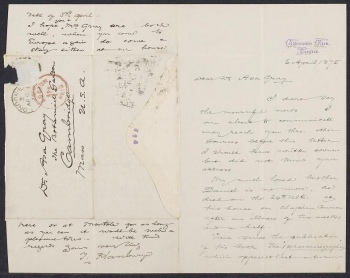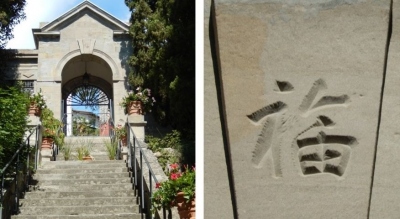The Clapham Society Local History Series — 40
Clapham Connections: The Hanbury Brothers and the Wider British World
By Andrew Hillier
Returning from China, Thomas Hanbury arrived in Marseilles on 25 January 1858 and, before boarding the train for Paris, scribbled a quick note to his brother, Daniel. ‘We are coming at last!’, he wrote,
Our passage from Alexandria has been most miserable, a strong head wind the whole way. I will write again from Paris …Can you arrange for Sampson and Emily to be with us at Clapham on First-day [Sunday], so that we may all meet together that day?
Aged 25, Thomas had spent five years in Shanghai and could not wait to see his family again – his parents, Daniel and Rachel Hanbury, his brother Sampson and his wife, Emily, and his three other siblings, Daniel, Anna and Capel – and they were all going to meet at their home in Clapham. Famous for the garden which he created at La Mortola, Ventimiglia, and for purchasing and donating the gardens at Wisley, Surrey to the Royal Horticultural Society shortly before his death, Thomas Hanbury is less well-known for the twenty years that he spent in China, although it was there that he made the fortune which funded those interests. A keen amateur botanist, he would maintain a detailed correspondence with his elder brother, Daniel, and send him seeds and cuttings for cultivation at his home in Clapham. Whilst much has been written about La Mortola, this article focuses on how, through the brothers’ relationship and interests, connections were forged, both practical and cultural, between Clapham, then still a village on the outskirts of London, and the wider British world.
Born in Clapham, the Hanbury siblings were all brought up in a substantial mansion on Bedford Lane (now Bedford Road) which had adjoining accommodation for the coachman. Their father, Daniel, was a partner in a successful pharmaceutical business in the City of London which his uncle, William Allen, had founded and he had joined at the age of fourteen. Daniel, junior, was taken on at the age of sixteen and would become a celebrated pharmacologist, writing a number of important works on botany and the use of vegetable products in medicine and compiling a detailed herbarium of the plants which he had collected or cultivated.
Thomas also started his career in the City, but in his case it was with a firm of tea merchants. Impressed by this determined and conscientious young man, four years later, they decided to send him to China. However, by the time he was setting off, he seems to have severed his ties with that business and instead entered into a partnership with four colleagues who accompanied him to China. The letters begin with his descriptions of the voyage out, the Overland Route by cart across the desert to Suez, followed by an extremely hot journey through the Red Sea to Point de Galle, Ceylon (Sri Lanka), and then on to Singapore, where he spent a couple of weeks, before finally reaching Shanghai in September 1853.
It was just ten years since the treaty port had been established following the 1st Opium War (1839-1842). A network of streets lined with colonial style buildings had been laid out, fronted by the Bund which ran along the Huangpu River and, here, westerners were allowed to reside and trade. Thomas was immediately taken with this small but thriving settlement on the edge of the bustling Chinese port city, and described the scene to his brother: ‘junks sailing up and down… twenty or thirty vessels and two or three steamers riding at anchor, showing the business done in every part of the world’.
Please click images to see a larger version and click outside the image to return.
Thomas Hanbury 1832-1907
With financial support from Thomas’s father, the business quickly prospered, mainly exporting tea and silk, but also dealing in any other commodities (with the exception of opium) which could be bought or sold on the Chinese and London markets. A devout Quaker, Thomas deplored the way western merchants treated the Chinese but found like-minded people as himself in the London Missionary Society – Dr William Lockhart who had set up the mission hospital and shared his passion for botany and Walter Medhurst, who had founded the mission station with Lockhart in 1844. An outstanding Sinologue and, as chance would have it, my great-great-great grandfather, Medhurst would help Thomas with his Chinese studies. Writing home, Thomas told his brother,
Thou wants to know what we do on First days [i.e Sundays]; well, I generally go to the Independent Chapel directly after breakfast, say 9.30, the service is over at 11. I then read or write till tiffin time, 1 o’clock; after tiffin I often walk into the city with Dr Medhurst or Dr Lockhart, in the evening to Dr Medhurst’s, where evening service is held.
Revd Dr Walter Medhurst DD (Hillier Collection)
Although William Lockhart and Walter Medhurst and his wife, Betty, were able to provide Thomas with some family life when he first arrived, there were few single western women in the settlement, and, despite his religious scruples, at some point, like many other westerners, Thomas would ‘acquire’ a Chinese ‘wife’ (dubbed at the time ‘a sleeping dictionary’). Although he maintained the relationship lasted only a matter of months, it was sufficient to produce a son, Ahsu, who was born in 1865, and, re-named Charley, was sent to Paris at the age of nine. There he boarded with a family, who were friends of Thomas’s, attended a local school and was visited by Thomas from time to time. And so a further China connection was forged. However, it would not last long as Charley would die at the age of eighteen. Although Thomas mentioned none of this in his letters home, he would in due course make full disclosure to his brother and to his wife.
By the time Thomas returned for his first furlough in 1858, the Taiping Rebellion, which had broken out in the early 1850s, was devastating China. Led by a religious fanatic, it would last some thirteen years and cause the death of over 20 million Chinese. However, it also gave Thomas, who had now gone into business with a London-based partner called Frederick Bower, his next and most important commercial opportunity. With many thousands fleeing from the rebels and taking refuge in the settlement, he bought and rented out property to the rapidly-expanding Chinese community. When he finally left Shanghai in 1871, he was the International Settlement’s largest private landowner and extremely wealthy.
Like Daniel, Thomas had early developed an interest in botany, inspired in part by their rambles on Clapham Common which, at that time, was much more densely covered in trees and undergrowth than now.
View from the Nine Elms, Clapham Common, looking south-west, Joseph Powell. c. 1823
There was plenty of scope for pursuing these interests in and around Shanghai, where Hanbury, Lockhart and the famous botanist, Robert Fortune, went out foraging for plants and also when Thomas was travelling to and from England and stopping off en route. His letters refer to his sending his brother seeds of wisteria, gardenia florida and cupressus funebris, along with those of medicinal plants and spices, which Daniel recorded in his herbarium, for example,
528 Amomum cardomomum L.
rhizome with inflorescence and detached spikes of fruit (2 specimens)
(1) From Java
(2) ‘bought in a drug shop at Singapore by Thos Hanbury, who states in a memo. ‘I have tried to get more like this on the bunch at almost every shop in the place, but could not succeed; this I found in an old bottle in a Chinese chemist’s shop’
At the same time, Thomas was also developing his own Chinese garden with Virginia Stock, ordinary Stocks, Banunculus, Salvia, Cytisus and other species which had been sent from Clapham. But by the mid-1860s, he was beginning to tire of China. Returning for a second period of leave in 1867, he found and bought La Mortola, a villa or palazzo overlooking the sea just outside Ventimiglia, which had plenty of surrounding land which he would gradually buy up. The following year he met and married Katharine Aldam Pease. Leaving Daniel to start creating the Italian garden, the newly-weds returned for one final stint in Shanghai, finally departing in 1872. Although he maintained his commercial interests in Shanghai, save for one short visit, Thomas would not return. A final note in the published letters, which Thomas’s wife, Kathleen, addressed to their children, records their departure and journey home.
We left Shanghai (your father and I, Cecil [their baby son] and his ahma [sic]) at daylight on 16th September, 1871, and reached Marseilles on 30th October. On the morning of 1st November we started for Mortola, arrived at Mentone at 3.45 p.m., and found D[aniel].H. at the station to meet us. We remained at Mortola till 22nd November, during which time Mr. Durham, a young artist who had come from England with D. H., made a sketch of Cecil and the Chinese nurse, sitting in the Pergola.
From there they made their way to Paris and finally to the family home in Clapham. Intriguingly, therefore, this note hints at one further connection between China and Clapham – the arrival of baby Cecil’s Chinese amah, something which would have been highly unusual at the time. Frustratingly, the amah is not mentioned again and we do not know how long she stayed with the family. Thomas did not remain in Clapham but instead bought the old farmhouse in Addiscombe, Croydon.
Daniel Hanbury 1825 -1875
Daniel, meanwhile, was still living in Clapham. A life-long bachelor, some ten years earlier, he had left his parents’ home and moved to Hollywood House in Nightingale Lane (what is now number 7). With its large garden and a hot-house, complete with stove, he was able to cultivate and ‘ripen’ plants despatched from India, China, Southeast Asia and the Americas and those he had
collected on his own travels.
Hollywood House, Nightingale Lane, 2021. Photograph by the author
These included items from an expedition he had made to Syria with the Director of the Royal Botanic Gardens, Kew, Sir Joseph Hooker, which, again, he meticulously recorded in his herbarium, including,
568 Liliacae smilax aspera
two flowering stems and fruiting twig:
Between Safed and Mijdel Kerum; climbing the trees; very fine. Common about Beyrout, Syria; Dr J.D. Hooker and D. Hanbury Sept and Oct. 1860
Daniel maintained an extensive correspondence with other botanists including Hooker’s great friend, the eminent American Darwinian, Professor Asa Gray, to whom he sent samples, as we see in this list.
Items sent to Asa Gray, March 1872
Gray returned the compliment and sent Daniel samples from his home in Harvard as well as visiting La Mortola with his wife, Jane. In the following letter, Daniel thanks Gray for some seeds of Fremontia California or flannel bush, which he says he will forward to his brother in Italy whilst saving some for his garden in Clapham:
Letter from Daniel Hanbury to Asa Gray, 17 August 1874
However, just nine months after writing this letter, Daniel died at his Clapham home having contracted typhoid. Thomas was shattered as is clear from a letter he wrote to Gray giving him the sad news.
Letter from Thomas Hanbury to Asa Gray 6 April 1875
Over the next thirty years, Thomas would create the beautiful garden at La Mortola, in part as a memorial to his beloved brother and to their early life together in Clapham.
La Mortola , 2019, photograph by the author.
There would be one further connection with China. In 1879, after two years in London, its first ambassador to the Court of St James’, Guo Songtao, was recalled. Through Walter Medhurst, he had met Hanbury in Shanghai and on his way home visited La Mortola, a visit which Thomas recalled in a lecture delivered in 1904. ‘In my opinion’, he began
the best-abused and most unjustly treated people in the world at present are the Chinese… In that so-called benighted country, where I resided for thirteen years [sic], there is this commendable custom. If your friend builds a house, he asks you to paint a scroll or to write something in large characters that he may look at every day. Now the Minister wrote for me only the single character ” Fo,” which means ” happiness ” ; and this character, being 12 inches high by 6 broad, I had it copied and cut in white marble and put over my entrance gate, where it remained till the terrible earthquake of 23rd February [1887].
Left: The archway, La Mortola, with Chinese headstone. Photograph by the author, 2019
Right: Guo Songtao’s inscription 福 on the arch headstone
Fortunately, the arch was rebuilt some time after that lecture was given and can be seen today complete with the headstone bearing Guo’s inscription. This can also be translated as meaning ‘blessing’ or ‘good fortune’, 福, a fitting memorial to the amicable relations between Britain and China which Thomas Hanbury so wished to foster. Now the property of the University of Genoa and beautifully restored, the garden is open to the public.
Further reading
The Letters of Thomas Hanbury (London: West, Newman & Co, 1913). These can be accessed at https://archive.org/details/cu31924021575034/mode/2up The same web-site
https://archive.org// has extracts from Daniel Hanbury’s herbarium and images of the letters and the Hanbury brothers shown above.
Maura Muratorio, Grace Kiernan, Thomas Hanbury e il suo giardino/ and his garden Bacchetta Editore, Albenga, 1992
Alisdair Moore, La Mortola: In the Footsteps of Thomas Hanbury (London: Cadogan Guides, 2004)
For Walter Medhurst, see Andrew Hillier, Mediating Empire: An English Family in China, 1817-1927 (Folkestone: Renaissance Books, 2020)
andrewhillier.org
ah12387@bristol.ac.uk
My Dearest Martha: the Life and Letters of Eliza Hillier – Hong Kong, Shanghai, London, Bangkok, will be published by City University of Hong Kong Press in July.
